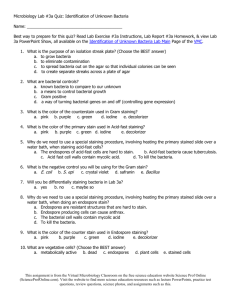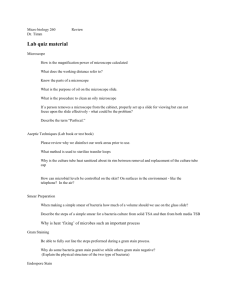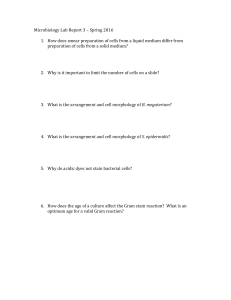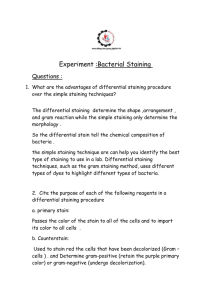Chapter 3 Observing Microorganisms Through a Microscope
advertisement
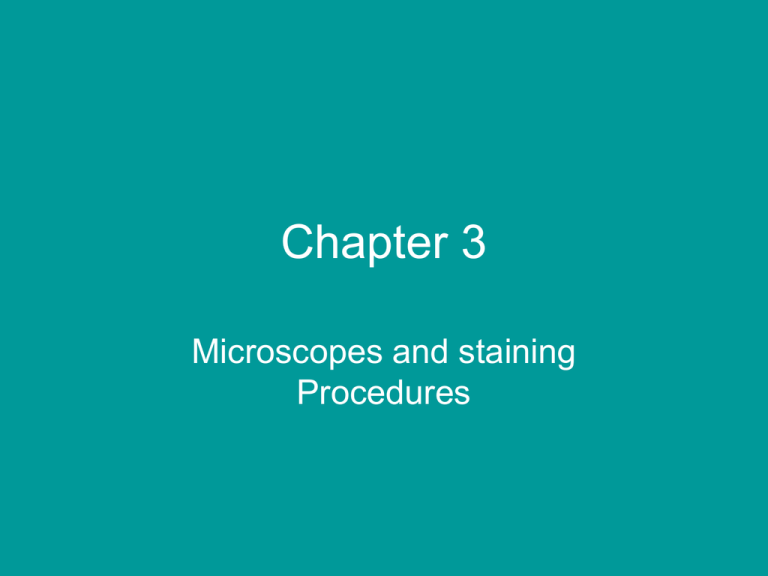
Chapter 3 Microscopes and staining Procedures • Measurement of microbes – units known as micrometers. • 1000 micrometers = 1 millimeter • Length of bacteria – 2 um to 7 um • Diameter 0.2 um to 2 um • Bright field microscope • Total magnification = magnification by the objective lens X magnification by the ocular lens • Resolving power (resolution) clarity/sharpness of the image • Oil immersion improves the resolving power • Dark-field microscope – cells are not stained. • Objects are bright/light. Background is dark. • Treponema pallidum – spirochete – syphilis. • Phase contrast microscope – no staining • Used to see internal structures – organelles. • Fluorescent microscope UV light is used to illuminate the object. • Cells are stained with fluorescent dyes. • Auramine O is used to stain Mycobacterium tuberculosis. • Cells show up as glowing yellow objects against a dark background. • Electron microscope • Transmission electron microscope (TEM) • Scanning electron microscope (SEM) • Beam of electrons are used in place of light. • TEM - thin sections of the specimen are obtained and placed on a copper mesh grid. Magnifies the object 10,000X to 100,000X. It has the resolving power of .0025 um. This used to observe internal structures. • SEM – used to observe structures found on the surface of microbes. Magnifies the object 1000X to 10,000X. • Resolving power of 0.02 um. • • • • • • • Dyes are salts Basic dye – positive ion has the color. Methylene blue chloride. Acidic dye – negative ion has the color. Sodium eosinate Basic dyes are used to stain the cell. Bacterial cell is negatively charged. It is attracted to the positive ions. Ionic bond is formed between the cell and the stain. • Negative cell is repelled by the negative ions. They are used to stain the background. • Nigrosin is used – background is black and cells are bright. Image is similar to what is seen in the case of dark-field. • Simple staining – a basic dye is used to stain the cell to determine the shape and arrangement of the cells. • Gram staining is a differential staining. It places bacteria into 2 groups. • • • • • Gram staining Crystal violet – primary stain Iodine – mordant Alcohol-acetone - decolorizer Safranin – counterstain • Gram + are purple • Gram – are pink • Gram staining is based on the cell wall structure. • Gram positive cells have thick cell walls. They hold on to the primary stain. • Gram negative cells have thin cell wall. • One or two layers of peptidoglycan. They also have an outer membrane – lipids. • Alcohol causes damage to the lipids. Primary stain leaks out. Acid-fast staining • • • • Differential staining Two genera are acid-fast Mycobacterium and Nocardia They have a waxy substance known as mycolic acid in their cell walls. • Carbolfuchsin – primary stain • Acid-alcohol – decolorizer • Methylene blue – counterstain • Acid-fast – red • Nonacid-fast - blue Capsule staining • A capsule is a gelatinous substance found around the cell wall. • It cannot be stained • Stain the background using nigrosin. • Stain the cell with crystal violet. • Background is black. • Capsule shows up as a clear ring around the stained cell. Endospore staining • Two genera of bacteria that make endospores are Bacillus and Clostridium. • Endospores are resistant to hostile environmental conditions. • Heat, UV light, disinfectant, desiccation. • Endospores are formed within the vegetative cell. Once the formation is complete, endospores are released into the environment. Endospore Staining • Malachite green - primary stain • Water – decolorizer • Safranin – counter stain

